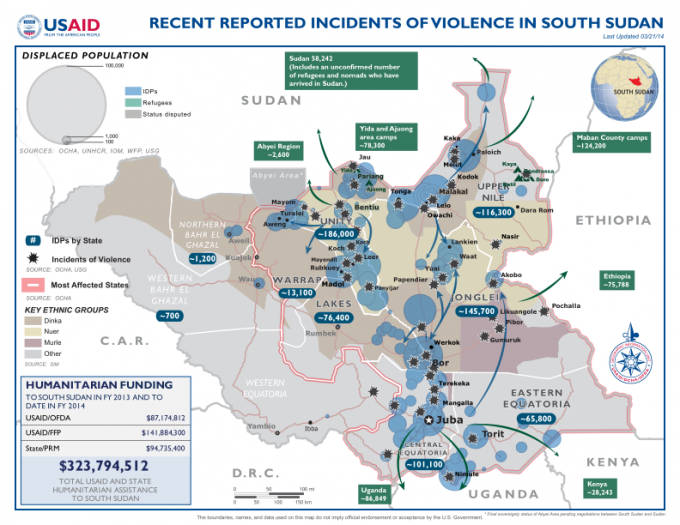As peace talks in Addis Ababa resumed yesterday, five days later than scheduled owing to disagreements over participation, a political compromise still seems to be in the future. Meanwhile, the humanitarian impact of the conflict intensifies day by day. As the rainy season approaches and transportation becomes increasingly difficult, as many as 4.9 million people are believed to be in need of assistance.
Displacement is foremost a result of insecurity in large parts of the country, which not only threatens violence but also affects livelihoods. The UN’s latest estimate suggests that more than 700,000 people are internally displaced while 217,911 are refugees in neighbouring countries. The number of refugees continues to increase: on average Sudan receives 350 refugees a day and Uganda 892, and in total more than 100,000 have fled to Kenya and Ethiopia. Internally, people flee from Unity State to Kordofan, from the Blue Nile to Maban in Upper Nile, and from Malakal farther South (see map).

As seen in many previous cases, large influxes of the displaced to areas already under pressure lead to increased local tensions and in many cases to outbreaks of violence with host communities. The latter often regard the displaced and refugees as security risks encroaching on their livelihood. Moreover, in marginalised areas people in camps might have better access to food and social services than the host population. Last week, locals in Nimule protested when refugees on their way to Ugandan camps settled rather than moving on to Uganda. In Maban County (Upper Nile) tension between locals and refugees has caused new outbreaks of violence. In the Yusuf Batil camp, the UNHCR reported four deaths after a clash between the host community and refugees. Residents living near the camp fled their homes in fear of more confrontations with camp residents.
With the coming rains these conflicts may escalate further. In the wet season the UN and NGOs’ ability to provide aid is limited because roads are muddy or blocked by flooding. In addition to an increasing number of IDPs in search of protection, those who already have reached a camp may be forced to move again. Last week, the UN had to transfer people from the flooded Tongping camp in Juba to the camp outside the town at Jebel. The urgency of a peace deal between the warring parties is further emphasised by the IGAD countries’ limited capacity to deal with the influx of refugees. On the Ugandan border, in Adjumani Refugee Camp, refugees’ unauthorised logging has created hostility from the host population.
The western part of South Sudan and the three states of Equatoria have remained relatively tranquil during the current conflict. But in more volatile areas such as Jonglei, a breakdown of government control may also spur violence not necessarily motivated by the political dispute between Kiir and Machar. In Rumbek (Lakes State), 15 people were killed last week as a result of a revenge attack related to incidents of August last year. Attacks like these continue unimpeded when government, the police and conflict-resolution mechanisms are unable to respond. Such disputes demonstrate that in the event of a peace agreement in Addis Ababa, reconciliation processes will have a lasting impact only if they encompass the local level. However, as new layers are added to old disputes and thousands experience the trauma of fleeing their homes, reconciliation becomes a greater challenge every day the civil war continues.
Helene Molteberg Glomnes, Research Assistant, PRIO and Øystein H. Rolandsen, Senior Researcher, PRIO.
Thank you for creating this South Sudan blog to keep us better informed. But as with Eric Reeves blog on Sudan, exposure has its limits.
Personally, I have given up on South Sudan. I mean, not on life there or its people, but on having an impact.
I have been following South Sudan civil war for 3 months now, and I must confess, my inner self sees no inner light and I have given up all hope that it will resolve short of all out winner take all civil war, like US’s , like Iraq and Syria now, like Israel and and Palistine forever. The South Sudanese are expendable to us, especially when US will not invade militarily and we have to use diplomacy, persuasion even, and how little impact we have then. Ironic, we do not want US to invade, intervene militarily, but there is no other force for good out there to do it. It is not that I have impact on issues, I have illusions I guess, that if I worked on an issue, like Valentino Deng’s school, Marial Bal, in South Sudan. An illsuion, so might as well free myself from it. I have given up on South Sudan. And I can follow events there, but more like an observer, than participant…BobLangfelder@gmail.com
Thank you Mr. Lagerfelder for reading and commenting on the blog. In my opinion there is a limit to what we foreigners can do for other people in countries far away from our own. But, I believe it is important for their and our own sake to know and understand the challenges South Sudanese are facing. I do wish to emphasise, however, that this blog has no political or activist aspirations (different from that of Eric Reeves) and is solely dedicated to analysis and sharing of information. If political biases or leanings are detected, these are unintentional.
Øystein